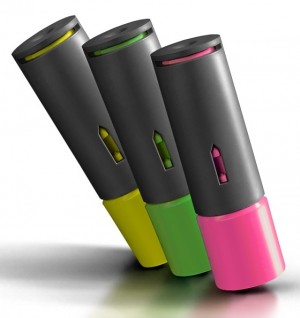Energy in the Air: An Interview with AeroShot Creator David Edwards
GALO: The AeroShot™ is also sold in France, a country that loves its café culture and has been hostile to quick-service, coffee-on-the-go brands like Starbucks. How is the French market responding to the AeroShot™?
DW: Interestingly, the AeroShot™ is the descendant of the Whif. The first product that I launched here [in France] was called “Le Whif” — we launched it in 2008 in a cultural contest exhibition. It’s quite a cultural product and we were invited several years to the Cannes Film Festival to animate the Whif there. It has really existed in a cultural milieu in France and it sells well at Galeries Lafayette. But frankly, our decision of a year and a half ago to go seriously commercial, and therefore, to focus on the energy drink market, led us outside of France. In fact, energy drinks are not a big thing here.
We went to the States and we will be launching seriously there in the next year, but we will remain a cultural thing here. Basically, we have a young following in France; we’re right next to the Louvre and the Palais Royale, and our crowd is 18 to 35, young, design focused — pretty much the same crowd as in New York. I love it, and we probably sell a few hundred AeroShot™ a week in the store here which is a good sale, but it’s not a product we would think of launching in supermarkets — but I’d like to point out that we’ve made no marketing attempts. What’s going to happen from the March timeframe is a much higher culinary “aeronutrition” line of products.
GALO: I don’t think anyone would disagree that Le Whif, giving the “experience” of chocolate through the air rather than eating, is novel and fun. But doesn’t removing the texture and the feel — and the calories! — of a food, especially in one’s mouth, also take away the pleasure of eating it?
DW: Yes. So, I think that to be clear here, the Whif chocolate is an experience to have and it is fun. This is a completely new way of eating chocolate for sure but it will not, for most of us, replace the joy of eating a chocolate cake. We found that the chocolate Whif is most attractive to three groups. One is children, who really love it. You can imagine that we have some major conversations going on with theme parks around the world. Second is that this is a very popular female product. The third thing is that we receive notes from patients who whether for a throat cancer or some other reason can’t swallow and so they receive food through a tube. Their interest in living is highly diminished by the fact that they can’t actually taste and so this gives them the ability to have the joy of taste without actually swallowing chocolate.
GALO: Your aerosol or airborne food systems like Le Whif and Le Whaf can’t replace eating because they don’t deliver calories. What’s the point of these systems — to be a sort of food play, a new way of interacting with food, or do you envision other uses? What foods or nutrients lend themselves well to these systems?
DW: You could think of four categories here. One is caffeine delivery. There are sports drinks, there’s coffee, there’s tea, there’s kind of a whole space here. Another space which is really interesting is vitamin mineral supplements. It’s possible to deliver all the effects of daily vitamins and minerals if we spritz them. If you think about it, the pleasure of swallowing pills on a daily basis is pretty limited. Something like 40 percent of vitamin users doesn’t like pills. There’s an indulgence space as well, so you can think of really interesting snacks. We’re working with some of the best chefs from all over the world right now to deliver all natural fabulous snacks. Think caviar and think foie gras and think pizza — it’s all natural and we fortify it with whatever nutrients might not be in it as a result of its being dry. It’s healthy and [with] no calories. And finally there’s a really interesting set of products around drugs. It’s a new way of putting ingredients in our bodies without pills. It’s a really interesting delivery platform.
GALO: The AeroShot™, along with your other products, comes out of an idea that the future of food lies in altering and re-engineering natural systems. How do you see this meshing with anti-industrial food movements that call for a return to natural, organic, “slow-food” processes?
DW: Everything we’re doing here is taking natural foods and changing their form. So we’re not doing any kind of modification or changing of the material. We’re not in the traditional science food area but we’re moving in a direction where food comes to us in a different way through packaging. From our point of view, the benefits of aerosol foods, both for the environment and for human health, are complimentary and actually transcend the benefits of organic foods. We have lots of conversations with the organic community. We are combining with organic foods; both the WikiCell work and the aerofood work have combined benefits. You will see over the next year or two product lines where it is all organic, and honestly, if you go back through the years for our chocolate products, we were using all organic chocolate and we were using the only biodegradable air-based delivery device that’s ever been made. We feel like there’s such an enormous opportunity to work in benefit of the environment.
The AeroShot is available in supermarkets in major US cities (check their Web site for availability in your zip code). It sells for $2.99 (individual) or $32.99 for a pack of 12.

